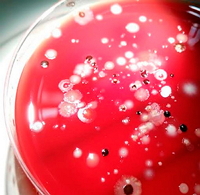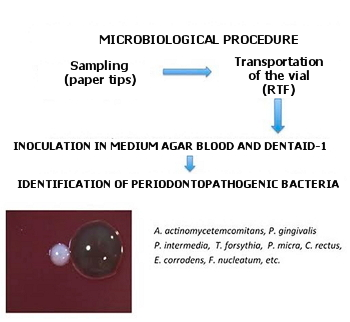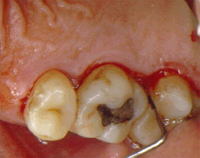DIAGNOSIS OF PERIODONTAL DISEASES BY ANAEROBIC MICROBIOLOGICAL CULTURES
|
Description |
Microbiological culture techniques for isolation and identification of pathogenic bacteria associated with periodontal infections.

Culture of subgingival bacterial plaque in which the great microbial diversity of this microflora is appreciated.
|
How does it work |

Scheme of the processing of clinical samples of subgingival bacterial plaque for microbiological diagnosis.
Microbiological samples are taken from the locations to evaluate using sterile paper points. These are transferred to a small vial of reduced transport fluid, preserving the anaerobiosis of samples. After transporting period up to 24 hours, the samples are dispersed, diluted and inoculated into different selective media, according to the origin of the sample. The plates are incubated in the appropriate atmosphere for the precise time. Subsequently they are isolated and identified mainly by microscopic and biochemical techniques.
|
Advantages |

Periodontitis. There is inflammation of the gingiva and presence of periodontal pockets.
It’s a useful tool in the diagnosis and treatment of periodontitis. It also allows the subsequent evaluation of antibiotic susceptibilities of the isolated bacteria.
|
Where has it been developed |
This technique has been developed in the Section of Periodontology Stomatology III Department of Dental Faculty. The research laboratory is using culture techniques as its aim of the research and as an aid in the diagnosis. In the field of the research, there are numerous studies published in national and international journals with high impact factor, including studies with others International Dental Faculties. In the clinical field, it represents a very useful tool for the diagnosis and treatment of patients attending in the Master of Periodontology of the same Faculty.
|
Y además |
With this technology, they can provide assistance in research and dentists in two ways:
- Add the microbiological analysis to research protocols and use microbiological variables in research projects in dentistry.
- Assist in the diagnosis and treatment of the patients at the dental clinic, by obtaining advice based on the microbiological analysis of the samples.
|
Contact |
|
© Office for the Transfer of Research Results – UCM |
|
PDF Downloads |
|
Classification |
|
Responsible Researcher |
Mariano Sanz Alonso: marianosanz@odon.ucm.es
Department: Stomatology III
Faculty: Dentistry


